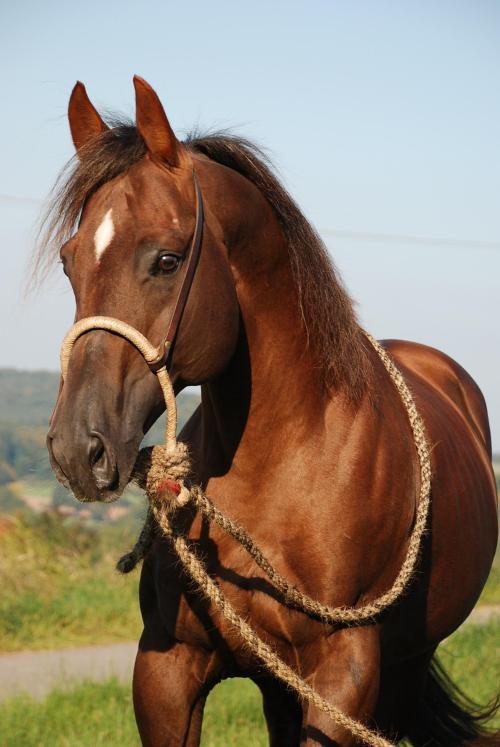10 Things You Might Not Know About Assisted Equine Reproductive Techniques
It is important to understand the benefits and costs of assisted reproductive techniques (ARTs) to ensure alignment with breeding goals. We collaborated with specialists in the UC Davis Equine Reproduction Service and Veterinary Assisted Reproduction (VetART) Laboratory to provide current information on these technologies.
1. Equine embryo transfer was developed in the 1970s to obtain pregnancies for older mares with reproductive problems. Breed associations initially limited its use. However, after increased adoption beyond overcoming fertility issues, restrictions were lifted and many breed organizations now allow unlimited registration of foals produced by embryo transfer.

2. Stallions produce "fresh" sperm throughout their lives, but mares are born with all the eggs they will ever have. These eggs exist in a suspended state of cell division, making them less fertile over time and contributing to reproductive issues in older mares. Although stallions produce sperm throughout their lives, sperm quality begins to decline around 13 years of age (Darr et al. 2017).
3. Transvaginal aspiration (TVA) is an invasive procedure and side effects, though rare, can occur. The donor mare may need to be out of training and competition for days to weeks after the procedure. Side effects can include minor bleeds and abrasions, hemorrhage, swelling, infection, fever, dullness, and pain. A study by the VetART Laboratory and Utrecht University reported that 24% of mares showed signs of discomfort the day after TVA (Martin-Pelaez et al. 2022). Serious complications are uncommon (<0.3%), but in rare cases (<0.05%) can be life-threatening (Hinrichs et al. 2025).
4. Equine eggs can be transported at room temperature without any effect on quality. Unlike many other species, immature equine eggs exhibit remarkable tolerance to handling and shipment. They can be placed in commercial embryo-holding media and successfully stored or transported for up to 24 hours at room temperature (Dini et al. 2016). They remain viable for over 48 hours at a slightly lower temperature (17°C). This unique characteristic enables flexibility in scheduling intracytoplasmic sperm injection (ICSI) procedures. Additionally, it facilitates the collection of eggs at a clinical facility and overnight shipment to a laboratory, enhancing efficiency and accessibility.
5. Laboratory-produced equine embryos can be frozen indefinitely. This facilitates wide geographic distribution of valuable genetics, flexible use of recipient mares, international trade, and storage of embryos for young individuals that are not yet proven.
6. Embryos can be produced in a laboratory using eggs from mares that have been euthanized, but euthanasia solution can affect fertilization. A study by the VetART Laboratory showed that pentobarbitol, the most common euthanasia solution, reaches eggs immediately after euthanasia. Although embryos can be produced, lower numbers may be obtained, especially with prolonged exposure of eggs to the drug (Martin-Pelaez et al. 2023).
7. The use of sex-sorted semen, which revolutionized AI cattle breeding, remains limited in horses. Unlike in cattle, sex-sorted equine sperm do not freeze well, which results in reduced semen quality and lower pregnancy rates following artificial insemination. However, studies have shown promising results for the use of sex-sorted sperm for ICSI (Dini et al., 2023).

8. Identical twins are rare in horses but may be more common with embryos produced in a laboratory. Increased incidence of identical twins has been documented after the transfer of in vitro-produced embryos in humans, and this also appears to be true for horses. Twin equine pregnancies usually result in early embryo loss or abortion. Twins carried to term can cause foaling difficulties, future fertility problems, and the birth of compromised foals. Although there is a higher prevalence (1.6% - 0.4%) of twins from laboratory-produced embryos, it is still rare (Peere et al. 2022).
9. Unlike in livestock and humans, conventional in vitro fertilization (IVF) is not commercially available for horses. Early attempts to produce foals through IVF had inconsistent outcomes. A breakthrough in 2022 using fresh semen led to live foal births (Felix et al., 2022), but reliance on fresh semen limited viability. In 2024, the VetART lab (Martin-Pelaez et al.) had success using IVF with frozen-thawed sperm, demonstrating embryo production rates comparable to ICSI, enhancing the commercial applicability of equine IVF.
10. Hundreds of horse clones have been produced, but cloning efficiency is low. Cloning is an ART in which the foal produced is genetically the same as the donor. It is highly technical and costly, with a low success rate. However, it is valuable for preserving elite genetics from horses that are successful in competitions but cannot breed, such as geldings, or individuals that suffer from sudden disease, injury, or death. Although the cloning procedure itself is costly, the cost to preserve cells from elite horses is relatively low, allowing for potential reproduction in the future as technology advances and becomes more widely accessible.
